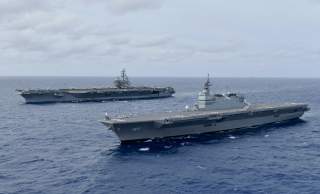Japan Wants To Fly F-35s From Its Own Aircraft Carriers, Here Is How It Could Get Them
The Japanese government in November 2018 announced that it plans to enhance its two Izumo-class helicopter carriers in order to support F-35B Lightning II stealth fighters.
Key point: Transforming the two helicopter carriers into aircraft carriers won't be easy.
The British company that built the Royal Navy’s two new Queen Elizabeth-class aircraft carriers wants to help Japan modify some of its own ships into carriers.
The Japanese government in November 2018 announced that it plans to enhance its two Izumo-class helicopter carriers in order to support F-35B Lightning II stealth fighters.
The announcement followed years of speculation that began even before Izumo commissioned into service in 2015.
“Since we are equipped with such vessels, it is desirable that we will use them for various purposes,” Japanese defense minister Takeshi Iwaya told reporters. “We would like to advance our research and studies on this.”
BAE Systems wants to do the work, Natasha Pheiffer, the company’s managing director in Asia, told Flight Global. “She feels that BAE is well placed to assist Tokyo with the integration of fixed-wing fighters aboard the two ships owing to its work on the U.K.’s Queen Elizabeth-class aircraft carriers, which will also operate the F-35B,” Flight Global noted.
Tokyo plans to order another 100 F-35s to supplement the 42 stealth fighters it originally ordered in 2011. The first batch of Japanese F-35s are all A-models that require conventional runways. The new batch presumably would include some vertically-landing F-35B models for shipboard use.
Transforming the two helicopter carriers into aircraft carriers won't be easy. The Izumo-class vessels are small for aviation ships. More vexingly, Japan hasn't operated fixed-wing aircraft from ships since World War II, and will need to train pilots, staff and maintainers for the unique challenges of carrier operations.
But other countries have succeeded in operating fixed-wing planes from small aviation ships. Most notably, Italy. Australians are debating whether to modify their own small aviation vessels to carry F-35s.
Japan's post-war constitution forbids offensive military operations. For decades, the country's leaders have interpreted the prohibition to mean the Japanese navy legally could not possess aircraft carriers.
The Japanese fleet sidestepped the carrier-ban by acquiring what it called "helicopter destroyers" -- that is, surface warships with hangars and unusually large flight decks.
The Izumo class stretched the credibility of the "helicopter destroyer" moniker. The type lacks major weaponry. Its flight deck extends from stem to stern. It's a carrier in everything but name. In practice, Izumo and sister ship Kaga, which commissioned in 2017, only have embarked helicopters.
Each 814 feet long and displacing 27,000 tons of water while fully loaded, Izumo and Kaga are small for carriers. The U.S. Navy's supercarriers each are a thousand feet long and displace more than 100,000 tons. The Americans' amphibious assault ships -- which support helicopters, AV-8B Harrier jump jets and F-35s -- are around 850 feet long and displace 41,000 tons.
But the Japanese ships aren't the smallest aviation ships. The dubious honor belongs to Thailand's Chakri Naruebet, which is just 600 feet long and displaces 11,500 tons but still managed to operate a handful of first-generation Harriers until the aging planes finally went into storage in 2006.
In size and function, the Izumos most likely will match Italy's flagship Cavour, an 800-feet-long amphibious assault ship that displaces 30,000 tons while fully loaded. Cavour typically embarks five Harriers alongside helicopters. Italy is buying new F-35Bs to replace its 16 Harriers.
Lockheed Martin designed the F-35B to match the deck "footprint" of the Harrier. While an F-35 occupies the amount of deck space that a Harrier does, the stealth fighter requires more intensive maintenance -- and its engine exhaust is much hotter than the Harrier's is, requiring the launching ship to have a special, heat-resistant deck coating.
Recoating the Izumos' decks is a straightforward procedure. Potentially more difficult is reorganizing the ships' internal spaces to accommodate the crew, parts, fuel and weapons an F-35 detachment requires. That’s the kind of work BAE Systems presumably would take on if Japan were to hire it for the Izumo conversions.
The modifications certainly are feasible, according to one Australian expert who studied the possibility of upgrading the Australian navy's Canberra-class assault ships in order to embark F-35s. A Canberra is 760 feet long and displaces 30,000 tons, making it roughly the same size as an Izumo.
"For 30 years or more the U.K. and U.S., using AV-8Bs and Sea Harriers, have delivered significant operational effect from similar platforms," wrote Steve George, a former Royal Navy engineering officer.
"In my experience, the key challenge in delivering a viable maritime aviation capability wouldn’t be the equipment, but in re-generating the required naval-aviation expertise," George added.
Fortunately for Japan, its navy enjoys a strong alliance with the U.S. Navy. As Tokyo begins preparing the Izumos for F-35s, the Japanese fleet, in theory, could send pilots, staff and crew to train alongside their American counterparts who are already operating F-35s from ships.
David Axe serves as Defense Editor of the National Interest. He is the author of the graphic novels War Fix, War Is Boring and Machete Squad. This article first appeared earlier this year.
Image: Reuters.

